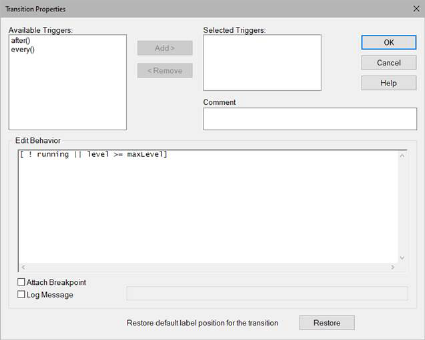
A transition is a direct relationship between a source state and a target state. It may be part of a compound transition, which takes the state chart from one state configuration to another, representing the complete response of the state chart to an event.
By default, transitions are bendable. To create straight line transitions, activate orthogonal drawing. You can also move where the transition attaches to a state element.
Constraints
•A fork segment must not have guards or triggers
•A join segment must not have guards or triggers
•A fork segment must always target a state
•A join segment must always originate from a state
•Transitions outgoing pseudostates may not have a trigger

Attach Breakpoint: Sets a breakpoint the transition that causes the simulation to stop after the corresponding Embed time step is complete.
Available Triggers: Lists all triggers within the scope of the transition. There are two built-in triggers: after() and every().
Edit Behavior: Defines the transition specification. It can contain triggers, a Boolean guard, and a behavioral expression.
Log Message: Logs the specified message when a transition behavior is executed.
Restore: Repositions the transition specification label to its default location in the middle of the transition arc or line.
Selected Triggers: Lists the triggers associated with the transition.
See Examples > State Charts > TransitionGuard001.